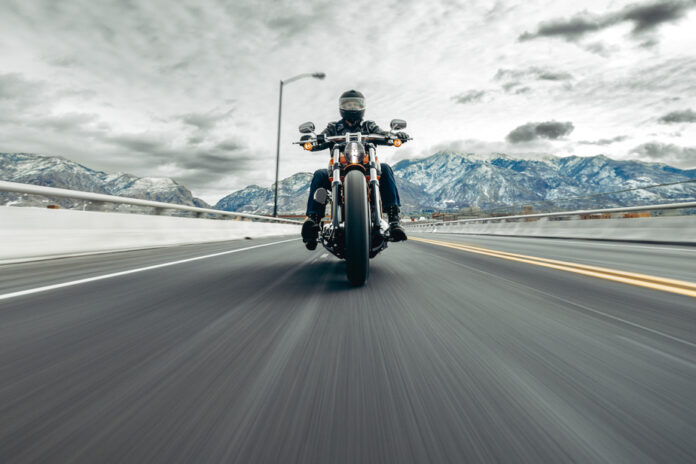Some dream of a shiny Harley for decades before finally taking action. Others make the jump at a very young age by riding on any scooter. And still others start “rolling” to complete a challenge they set themselves. But regardless of the path that brought them to the bike, when it comes to explaining why, the answer often comes down to this: you have to. These people represent only a very small percentage of the population. No one knows why this magnetism affects them but not others, and no section of society is immune. Sometimes marginalized, sometimes marginal. Such are, in short, motorcyclists.
Oh yes. Accurately describing the experience is difficult. Without meaning much, a strong “sense of freedom” is the most common explanation. Even our collaborator is not sure how to formulate the ideal answer. The best description he had heard to date came from Willie G. Davidson whom he interviewed a dozen years ago. Harley-Davidson’s chief stylist, also hesitant about the subject, explained that referring to an amplification of the senses is a good description. An interesting observation, which turns out to be absolutely true with regard to hearing, touch, smell and sight. And the taste? Snacking on a motorcycle ride is much better!
Oh yes. Especially without experience. Apart from their equipment, their attention and their skill as drivers, absolutely nothing protects motorcyclists against a pack of metal boxes driven by increasingly distracted and impatient people, against the dangers of a poorly maintained roadway or against a thousand and one other situations could cause an accident. One of the greatest dangers, however, is the motorcyclist himself, for example, when he does not have enough judgment not to ride drugged or drunk, which is unfortunately not uncommon. As for the motorcycle, it should be chosen after careful consideration, but no new mass-produced model is more dangerous than another.
The purchase of a motorcycle should logically be studied and planned. But dealers twiddle their thumbs on rainy days and become overwhelmed on sunny days, revealing a strange reality: a motorcycle often turns out to be an impulse buy. To avoid ! Read, “youtubez”, shop. Drop the phone and go see and touch the models that interest you. Sit on it. Are they too tall, too heavy, too aggressive in terms of ergonomics? Then come the questions that only you can answer. You start: something light, but not overly powerful, is ideal. Aiming higher is possible, but only if you have the required discipline. Do you have it?
A big question. Let’s stay in the new, since the second-hand market brings the aspect of a very specialized mechanical check. First, what does your heart say? Then, in that order, what does THE reason say – not YOUR reason, which is likely to be biased? A large gap is not uncommon, rest assured, but an effort should be made to reduce it. It’s as illogical to start at the controls of a touring Harley approaching half a ton as it is to start out in a gigantic adventure-class cruiser or even a barely street-legal race machine. But a slightly lighter Harley exists, as does a less imposing adventurer and a less explosive sportswoman.
How can you fly over the motorcycle without addressing the three-wheeled option, especially in Quebec where the most advanced vehicles of its kind are produced? The Can-Am (BRP) Spyder and Ryker offer an interesting option to those who admit to being both seduced and scared by the bike. Regardless of the model, the configuration with two front wheels and one rear wheel allows for a motorcycle-like experience, but significantly less complex when it comes to driving. Harley-Davidson also offers three-wheel (two rear, one front) variants of its most popular models. In all these cases, the driving license can be obtained very quickly.
Just under $4,000 (before taxes and miscellaneous fees) is enough to hit the road in a small, brand-new 2023 Honda XR150L. But we will probably get tired of it quickly. On the other hand, for around $9500, we can consider a friendly Kawasaki Z650 that will remain satisfactory for years. So, let’s say between $5,000 and $10,000 is enough to get into a completely decent first new motorcycle. As far as gear (jacket, helmet, boots, gloves), plus or minus $1500 is a good starting point. As for the motorcycle driver’s license and the various steps required to acquire it, a budget of $1,000 to $1,500 must be planned.
The best advice is math. It is simple to apply and very effective in terms of safety, but it is only accessible to disciplined motorcyclists. It is about reducing risk. Driving at 120 km/h on an empty highway in good weather is essentially risk-free. Driving at 75 km/h in the city during rush hour is extraordinarily risky. Staying in the blind spot of a car entails an unnecessary risk, but one that is easily eliminated by moving away from this area. And so on. You can ride a motorcycle taking risk on top of risk, or you can work to systematically reduce those risks. Each motorcyclist makes his choice.















